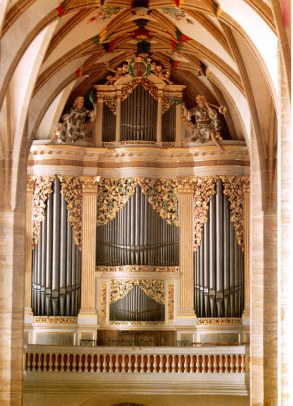 |
 |
 |
|---|
in Freiberg Cathedral, Saxony by GOTTFRIED SILBERMANN
Honorary Court and State |
Germany is exceptionally rich in historic organs, and a particularly fruitful area for exploration is the state of Saxony in southeast Germany, with no fewer than thirty-one baroque instruments by one master-builder, Gottfried Silbermann, most of them in near-original condition. Gottfried Silbermann (1683-1753) and Johann Sebastian Bach (1685-1750) were contemporaries and are known to have worked together as colleagues and friends. |
 |
 |
 |
|---|
From 1702 to 1707 Gottfried studied the arts of organ-building with his elder brother Andreas in Strasbourg, and for two of these years with Thiery in Paris. A condition of his elder brother's tutelage was that Gottfried would not work in his brother's "territory"! So in 1710 Gottfried returned to his native Saxony and set up shop centrally in Freiberg, bringing with him qualifications and certificates which immediately established his reputation locally. The following year, in 1711, Freiberg Cathedral invited the young builder, then only 28 years old, to construct a new organ of three manuals and pedal with 44 registers. This was completed in 1714. It was thoroughly restored in 1982/1983, and retains very closely its original condition.
The specification and design of the instrument were largely influenced by the then cathedral organist Elias Lindner, a pupil of Kuhnau, also a lawyer and a mathematician.The casework was also Lindner's design, and was to influence all of Gottfried Silbermann's subsequent organ cases. The design reflects the internal structure: each section – HW, OW and BW – is kept visually separate: the pipework of the OberWerk (OW) is located in the section at the top of the organ case, while the BrustWerk (BW) is right above the console. The HauptWerk (HW) occupies the rest of the case. |
| Hauptwerk C, D - c"' Bordun 16' |
Oberwerk C, D - c"' Quintadehn 16' |
Brustwerk C, D - c" Gedackt 8' Couplers (slider) |
Pedal C, D - c' Untersatz
32' Tremulant Schwebung |
Freiberg Cathedral provides ample opportunity for visits and auditioning. Cathedral guided tours with organ introduction are held on Sundays at 11am throughout the year, and additionally on Thursdays at 2pm from May to October. Also from May to October, the 8pm Thursday organ recitals are a long tradition much enjoyed.
Freiberg is in fact proud home today to no less than four Silbermann organs in three churches. In the Jakobi-Kirche a two-manual, 20-register organ built in 1717; in the Petrikirche a larger, two manual organ with 32 registers built in 1735; and in the Cathedral, two Silbermann instruments. The smaller, below center, is a one-manual instrument, originally built for the Johannis-Kirche and moved to the cathedral in 1939. |
 St Jakobikirche |
 Small organ, Freiberg Cathedral |
 Petrikirche |
|---|
Following the success of his Freiberg Cathedral organ which was universally well received, both for its fine sounds and its technical excellence, business moved briskly thereafter, and Silbermann's instruments would finally total forty-five, all within the relatively narrow area of Saxony. Today there are still thirty-one Gottfried Silbermann organs in original baroque condition, all located within the borders of, or very close to Saxony. |
 |
|---|
Such did his reputation grow, that Gottfried Silbermann felt confident to request an official title from Frederick I, at that time King of Poland and Duke of Saxony. His request is dated 10th June 1723 and on the 30th June he was granted the privilege he had sought: "Honorary Court and State Organ Builder to the King of Poland and Duke of Saxony". It sounds even better in Baroque German! |

Perhaps the single most important feature of Gottfried Silbermann's instruments is their distinctive sounds. From the silvery flutes to the strong and reedy 16' pedal Posaune (Trombone) which provides that fundament or bass support that Bach considered so essential, Silbermann's sounds were unique, and indeed were constantly praised by organists in their testimonies of his instruments. Frequent reference is made to a play on his name, as organists praised his "Silberklang" or "Silvery Sounds". Mozart commented emphatically: "These instruments are magnificent beyond measure".
To hear the famous Silver Sounds, check Gottfried Silbermann: Organ CDs for CD details and music samples. |

|
There's a lot more information about Gottfried Silbermann on the internet. And in Frauenstein (see map above) there is a Museum dedicated to this great organ builder.
To begin, if you have not already done so, you might like to visit the Museum and main Silbermann site Then follow up with this selection!
GOTTFRIED SILBERMANN: ORGAN INVENTORY
Planning your SILBERMANN Organ Tour
For further information about Frauenstein, home to the Silbermann Museum,
The Silbermann Organ at Nassau
Die Gottfried-Silbermann-Orgel zu Ponitz
The Dresden firm of Jehmlich Orgelbau
Similarly
the Bautzen firm of Hermann Eule Orgelbau
Through the legacy of his instruction, designs, and his pupils, Gottfried Silbermann was to influence organ-building in America, and, believe it or not, the development of the modern piano! Check
In 1736 Silbermann built a magnificent 3M+P/43 organ for Dresden's Frauenkirche. In 1945 organ and church were completely destroyed. The Frauenkirche lay in ruins until 1994; a grand program of rebuilding was undertaken
Natürlich steht Ihnen eine deutsche Gottfried-Silbermann-Web-Seite zur Verfügung:
Here's a useful "dictionary" for organists working with German websites:
Check the |
